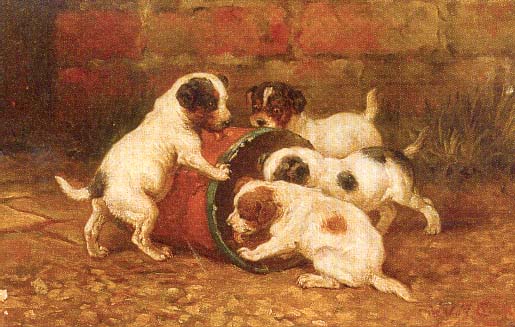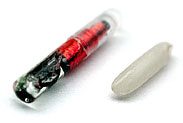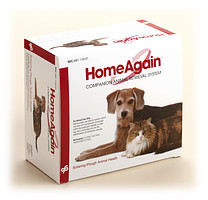|
|
Microchips,
For a lot of dogs in America, getting lost is fatal. The simple but harsh truth is that many dogs are destroyed at shelters every year because their owners cannot be found -- the collar or tag comes off in the brush or is even taken off by some idiot who has custody of the dog for a few minutes on a country road ("I took off the collar to read it, and then the dog just took off into the bushes ..." Some of us even have dogs that are cute enough to be stolen. The chance of a working terrier getting seriously lost is much higher than for a couch-potato pup that slips out the front door and simply wanders off into the neighborhood where it is soon to be spotted. When out hunting, we are often far from home, and our dogs may be out of sight for stretches of time -- hopefully underground, but not necessarily (everyone has had a dog slip out the back unseen). Another problem is that, when hunting, normal nylon collars with dangle tags cannot be worn. Compounding the potential for problems is the fact that dogs in a hard-hunting mode are very prey-driven and are able to go off on their own if they think it will provide a dividend. If there are too many loose dogs in the field (a mistake!) it's hard to keep your eye on every dog 100% of the time, and the one out of sight is sure to be the one that gets lost. If you lose your dog, how can you get it back? And if your dog is found and turned over to a local pound, how will the authorities know for sure your dog isn't a stray and should not be destroyed? Finally, if you find a dog, how can you get it back to its rightful owner? There are three ways your pet can be identified even without a collar. The best idea is to have all forms of identification placed on your dog. Better safe than sorry! Slide Tag on the Collar Get a simple brass slide
tag and put in on each of your locator collars. Get
the Microchips A microchip
is a tiny bit of electronic wizardry, the size of a grain
of rice, that is injected between the front shoulder
blades of the dog. Nearly all shelters and vets now have
microchip readers, and it is now routine to scan for a
chip in a found dog. When a There are two common microchip identification systems, HomeAgain, and Avid. Both systems work and the newest line of readers, which came out in 1996, will read all major kinds of chips. HomeAgain is owned by the AKC but it can be used on any dog, and registering your dog with the HomeAgain microchipping system is not AKC registration in any way, shape or form. When a vet or shelter reads the HomeAgain microchip, they simply call a toll-free number that is open 24 hours a day everyday (1-800-252-7894) to get your name, phone number, address and any other contact information you have made available. The HomeAgain chip is made by Schering-Plough and is supposed to be resistant to migration or movement -- a problem with early chips on larger (or fatter) dogs. Once the chip is bought, the dog is registered with the AKC for just $12.50 for the life of the animal.
The HomeAgain microchip kit costs just under $10 per dog from Countryside Vet Supply (http://www.countrysidevetsupply.com/countrysidepet/homeagain.html) .The microchip is injected by subcutaneous injection just like a vaccine (see vaccine page at http://www.terrierman.com/vaccines.htm for how to do this). How does microchip identification work? The microchip is a passive device, meaning that the transponder carries no battery and it remains inactive except when it is being scanned. When the scanner is passed over the shoulder-blade of the animal, where the microchip has been inserted, a low-powered radio beam is sent by the scanner and it bounces off the chip and sends the code number in the chip back to the scanner where it is displayed on a small screen. The Avid system is similar to HomeAgain, and is used by the Canadian Kennel Club. Avid chips are not commonly sold in single-units but in bulk to veterinarians and breeders. For more information on the Avid system, see: http://www.avidmicrochip.com/ . TattoosTattoos are tattoos -- the old fashioned needle and ink kind -- and they are permanent. In general, an area under the back thigh is best as it's a common place to look and does not disfigure the dog like an ear tattoo. The procedure for a tattoo is pretty simple: the area for the tattoo is shaved and disinfected with alcohol, a light layer of Vaseline is applied to the area so the tattoo marker will move smoothly over the surface of the skin, and the number is applied. The area is then cleansed with Phisoderm or another disinfecting soap which removes excess ink from the skin. Any numbers that are not clear are retouched at this time. A final layer of Vaseline is applied over the finished tattoo to aid scabbing over. A very fine scab (barely visible) will form over the tattoo and will fall off after a day or two. It's best to keep the area around a tattoo scissored or clipped so it can be easily seen if the dog is lost. Do not tattoo a dog without registering the number with either the AKC or the National Dog Registry or Tattoo-a-Pet. An unregistered number is useless as it cannot get your dog back to you. Any number can be registered with the National Dog Registry, and all tattooed animals are eligible for enrollment in the AKC's Companion Animal Recovery system regardless of species, age, size or number used. The one downside to a tattoo is that they may fade or blur over time and become difficult to read. If you come across a stray dog with a blurred tattoo, shave the tattoo and wet it -- it may make the numbers a little clearer.
|

 smallest
size they make and then curve them a bit so they fit
flush against the dog's neck. I have had no
problems with these slide tags getting hung up, as they
are smaller than the deben locator, more flush than the
buckle, and they slide in multiple directions. A tag is always
the quickest, surest and easiest way for anyone to get
your dog back to you -- or your deben collar if it should
happen to slip off the dog. A good place to order tags
from is
smallest
size they make and then curve them a bit so they fit
flush against the dog's neck. I have had no
problems with these slide tags getting hung up, as they
are smaller than the deben locator, more flush than the
buckle, and they slide in multiple directions. A tag is always
the quickest, surest and easiest way for anyone to get
your dog back to you -- or your deben collar if it should
happen to slip off the dog. A good place to order tags
from is
 hand-held microchip reader is
passed over the dog's neck, it reveals a specially
designated number that can be matched back to you,
through a registry.
hand-held microchip reader is
passed over the dog's neck, it reveals a specially
designated number that can be matched back to you,
through a registry. The HomeAgain chip system is pretty
ideal. Each microchip is made from soda lime glass
which has been specially selected for biocompatibility.
The code is preprogrammed into the microchip, and the
code cannot be altered. Each microchip has its own
injection system which consists of a sterile applicator
with a preloaded sterile injectable transponder,
enrollment form and a collar tag. There's nothing
else you need other than $12.50 per dog to send in
to the AKC in order to enroll the number in their
permanent lifetime animal recovery registry.
The HomeAgain chip system is pretty
ideal. Each microchip is made from soda lime glass
which has been specially selected for biocompatibility.
The code is preprogrammed into the microchip, and the
code cannot be altered. Each microchip has its own
injection system which consists of a sterile applicator
with a preloaded sterile injectable transponder,
enrollment form and a collar tag. There's nothing
else you need other than $12.50 per dog to send in
to the AKC in order to enroll the number in their
permanent lifetime animal recovery registry.